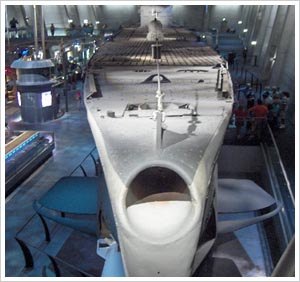Freighters sunk by German U-boats lure divers to Canadian coast
 Lance Cove, Canada - Almost seven decades have passed since German U-boats brought World War II to Canada's Atlantic coast. They sank four freighters with cargoes meant for England near Bell Island, in the province of Newfoundland and Labrador. The wrecks are still a magnet for divers.
Lance Cove, Canada - Almost seven decades have passed since German U-boats brought World War II to Canada's Atlantic coast. They sank four freighters with cargoes meant for England near Bell Island, in the province of Newfoundland and Labrador. The wrecks are still a magnet for divers.
On September 4, 1942, U-513 slipped under cover of night into Conception Bay near St John's, the province's capital. There it lurked off the steep coast of Bell Island. The next morning the submarine rose to periscope depth and spied its targets: two iron ore carriers in anchorage, the S. S. Saganaga and the S. S. Lord Strathcona.
At 11:07 a. m., two torpedoes struck the Saganaga, which sunk in fewer than 30 seconds. Several minutes later, the U-513 sent the Lord Strathcona to the bottom.
The island was the scene of a second German submarine attack two months later. U-518 hugged the coastline so closely that its crew could make out headlights of automobiles overhead on the island.
On the morning of November 2, U-518's captain gave the order to attack. An errant torpedo damaged Bell Island's Scotia Pier. The iron ore carriers S. S. Rosecastle and P. L. M. 27 were hit and sunk. Nearly 40 seamen died.
The Newfoundland militia fired from gun emplacements at the attacker but missed. The submarine escaped. "All that they hit was a cow," noted Rick Stanley, who runs a dive centre in Conception Bay South and grew up with the U-boat tales.
The four ships still lie where they sank. Stanley said he has taken scuba divers from all over the world to the wrecks. The divers, he said, want to see the aftermath of two of the few attacks by Nazi Germany in North America.
Little on Bell Island, which measures about 9 kilometres by 3.5 kilometres, recalls World War II. In front of a shop that sells cement animals is a small roadside sign directing visitors to the "Seaman's memorial and picnic area" in Lance Cove. The memorial is next to a trailer park with a view of the mainland on a grass-and-gravel beach strip at the foot of a hill. It consists of a flagpole, a few plaques with lists of names and a large anchor.
White buoys bob in the water a stone's throw from the shore. They mark the spot where German torpedoes sank the four ships. Stanley gladly takes non-divers around the island in a rubber dinghy. Waiting to be discovered are 70-metre-high cliffs of greyish-brown shale, colonies of sea birds and a wild and romantic lighthouse.
There are plenty of signs pointing the way to the No. 2 Mine and Museum, which showcases the reason that German submarines attacked. Under Conception Bay near Bell Island were the world's largest underwater deposits of iron ore. In long shafts below the seabed, miners extracted more than 70 million tons of ore from 1895 to 1966. One of the shafts begins under the small museum, which offers tours into the damp gloom of the mine. (dpa)